[G] CERAMICS AND POTTERY
1/234
There's no tags or description
Looks like no tags are added yet.
Name | Mastery | Learn | Test | Matching | Spaced |
|---|
No study sessions yet.
235 Terms
Ceramic
An inorganic, non-metallic solid made up of either metal or non-metal compounds that have been shaped and hardened by heating to high temperatures
Keramicos
Means pottery in Greek
Keramos
Meaning potter's clay and is used to describe a whole body of ware made of clay
Pottery
The process or forming vessels and other artifacts with clay and other ceramic materials like silica, hardened and sintered in fire
The Clay State or Greenware
The ware is formed but hasn't gone under firing. They are very brittle and are often sanded with fine grade sandpaper to ensure a smooth finish in the completed item.
Leatherhard
Refers to a specific stage during the drying of the object; Clay is still visibly damp but has dried enough to be able to be handled without deformation
Bone Dry
Term used to identify Greenware pottery that has dried as much as possible before it has gone through its first firing
The Biscuit State or Bisque
A term which means half-baked; When the ware has undergone a preliminary low range firing through an oven or a kiln; It is any pottery that has been fired without a ceramic glaze, plain red, white or brown
Bisquit Porcelain
An unglazed white porcelain that is treated as a final product, with a matte appearance and texture to touch
Glazed State
After ware has been covered with the glaze and has undergone a second firing, it is done to make wares impermeable to water and other liquids
Glaze
A mixture of chemicals, mostly silica, the major component of glass, clay, a melting agent, water, colorants and a suspension agent allowing the chemicals to stick together and not separate like oil and water; May be applied by dusting the unfired composition over the ware, or by spraying, dipping, trailing or brushing on a thin slurry.
Salt Glaze
A traditional form of glaze, high-firing and usually used on stoneware; Salt is introduced during the firing process, resulting a textured, granular surface
Ash Glaze
A type of glaze from the combustion of plant matter used as a flux; The variable nature of the raw material are unpredictable
Alkaline Glaze
A low-high firing depending on the alkaline flux, such as borax, potash, or soda ash. Frequently transparent, this can produce brilliant colors, such as Egyptian blue, using low temperature firing. Commonly used for crackle glazes and even on Japanese Raku ware
Lead Glaze
A type of glaze used for low-firing on earthenware; Results are a smooth glasslike finish that allows bright colors and decorative patterns to show through
Tin Glaze
A type of glaze like lead but with added oxide, making the result white, shiny, and opaque; Used for earthenware and provides a background for bright painted decoration
Feldspathic Glaze
A type of high-firing glaze which uses feldspars as base; Fused at a high temperature which is why they are only used for Stoneware and Porcelain; Creates a hard, glossy, and transparent surface
Coloring
Oxides were used to create colored glazes
Tin Oxide
An oxide that produces white powder
Cobalt Oxide
An oxide that produces grayish blue to pure sapphire, widely used in East Asia and Europe for blue-and-white Porcelain wares
Cupric Oxide
An oxide that produces a distinctive series of blues, and with excess carbon monoxide, yields a bluish red known as reduced copper
Cuprous Oxide
An oxide that produces a series of greens
Ferric Iron Oxide
An oxide that produces pale yellow to black, with the most important being a slightly orange red, known as Iron Red.
Ferrous Iron Oxide
An oxide that produces a type of green best seen on Chinese Celadon wares.
Manganese Oxide
An oxide that produces varying from bright red purple to a dark purplish brown, almost black; Aubergine Purple of Chinese wares was derived from this
Antimony Oxide
An oxide that produces yellow
Earthenware
Soft pottery that is the oldest and most universal; Natural clays fired at 900 to 1200 °C; Usually porous and opaque, pale tan to red and brown in color, and has a tendency to chip and break
Stoneware
Clays with a higher percentage of sand, fired at 1200-1280 °C; Extremely hard, usually vitrified and impermeable to water; Available both in dull and glazed forms either white or colored
Porcelain
Kaolin mixed with decayed granite and fired at 1280 to 1400 °C; Has a clear white color and is extremely hard and translucent; Hardest ceramic product that originated in China
Hard Porcelain
Porcelain fired between 2390-2570 F; Considered the best kind of porcelain made of kaolin and is called "true porcelain"
Soft Porcelain
Porcelain fired below 2300 F; More translucent, not white in color nor does it have the clear ringing tune of true porcelain; Suffers more damage through time
Bone China
White hard translucent ceramic ware; It gained the whiteness, translucency, and stability through the inclusion of calcium phosphate in the form of calcined ox bones; Requires at least 2 or more firings at different temperatures; Opaque but not as hard as porcelain
Petuntse
Also known as China stone; Less decayed, more fusible feldspathic material
Protoporcelain
Early vitreous wares produced by the Chinese
True Porcelain
These are white vitreous ware
Slip
A thick semi-solid fluid composed of clay and water into which the ware is dipped, dried then fired
Terra Sigillata
Means sealed earth; Comes from the name of a type of Roman pottery that was mass produced around the 15 Century AD; Have glossy surfaces ranging from soft luster. to a brilliant glaze-like shine, in a range from pale orange to bright red
Decalcomania
Art of transferring designs from a specially prepared paper to a wood or glass or metal surface
Lithographed
A printing process based on the principle that oil and water do not mix; This process systematically treats the surface, so the the image areas will accept the oily ink, while the non-image or blank areas are treated to repel the ink
Sgrafitto
The term come from the ltalian graffiare, meaning to scratch; Designs are drawn with a pointed tool that are scratched through the slip to reveal the body
Pierced
Decorative elements that involve cutting or carving through the clay to create intricate patterns or designs
Overglaze
Colored decoration is applied over a fired transparent glaze; Object is fired a third time to set the decoration; Third firing is at a lower temperature than glost firing, allowing for a greater range of pigments
In-glaze
Commonly used in tin-glaze earthenware, colored decoration is applied over a dried but unfired opaque glaze; During glost firing, the color and the glaze fuse together thus creating a uniform surface
Underglaze
Colored decoration is applied to an unglazed body, and then covered with a transparent glaze; The glaze then seals the decoration during the glost firing; Colors used are limited, as certain pigments, known as grand feu colors, can with stans the high heat of the glost firing
Primitive Ceramics
Archaeological evidence shows that primitive man first started to use ceramic sin a utilitarian sense; Vessels were fashioned made of hardened earth to serve as storage for grain and water; Usually plain but later on have included patterns like the zigzag and the chevron
Egyptian Ceramic
Pottery in Ancient Egypt served a different purpose other than as containers for practical or domestic items; Used in ritualistic rites that are geared towards the burial ceremony; Clothes, shoes, and other favorite items of the deceased are usually placed in earthenware and buried together with the body
Black Figure Ware
Figures are painted black on a red background
Red Figure Ware
figures are painted red on black background
White Ground Ware
Figures are painted either red or black on a white background
Drinking Cups
Which kind of Greek ceramics are these: Skyphos, Kylix
Bowls for mixing wine and water
Which kind of Greek ceramics are these: Column Krater, Volute Krater, Calyx Krater, Bell Krater
Wine Jugs
Which kind of Greek ceramics are these: Oinochoe. Oinochous
Water Jugs
Which kind of Greek ceramics are these: Hydria, Kalpis
Oil Flasks
Which kind of Greek ceramics are these: Lekythos, Aryballos
Storage Jars
Which kind of Greek ceramics are these: Amphora, Neck Amphora, Pelike
Wine or water container
Which kind of Greek ceramics are these: Stamnos
Cloisonne
An ancient technique for decorating metalwork objects, in recent centuries using vitreous enamel, and in older periods also inlays of cut gemstones, glass, and other materials; Soldering or adhering silver or gold wires or thin strips placed on their edges
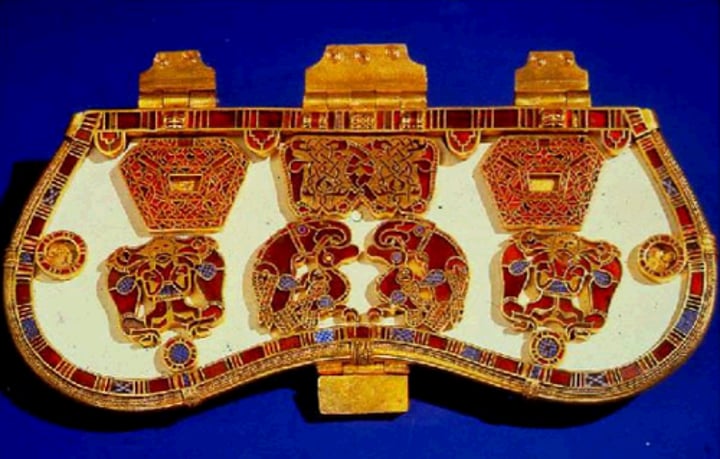
Italian Ceramics
Period when pottery became a vehicle of artistic expression; First instance in which a recognized school of art occurs in Italy— given it a value not inferior to canvasses and frescoes of the same period
Mezzo-maiolica
A type of tin-glazed earthenware pottery that was produced in Italy during the Renaissance period characterized by its white glaze (tin-based) and its vibrant, colorful decoration painted over the glaze
Majorca Ware
A tin-glazed earthenware produced on Mallorca
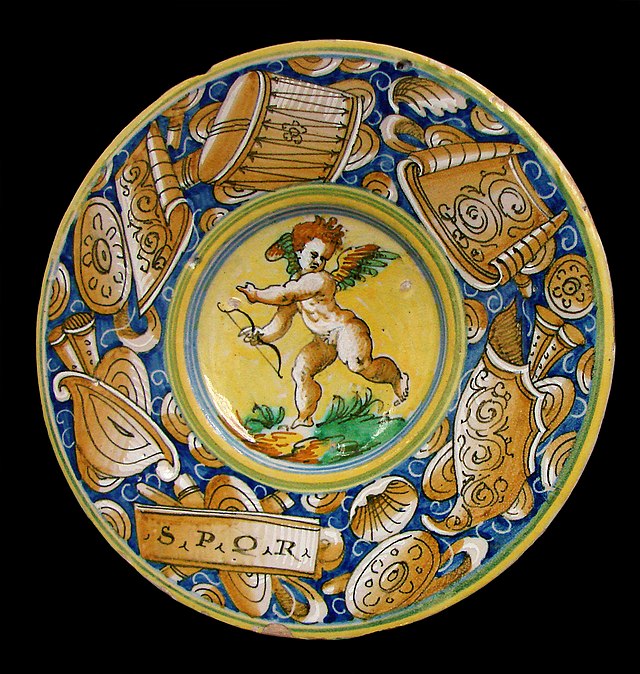
Bianchi di Faenza
A type of Italian Renaissance maiolica pottery that was produced in Faenza known for its characteristic white tin-glazed surface decorated with intricate designs in blue or other colors painted over the glaze

Istoriato Style
A specific style of maiolica pottery decoration that emerged during the Italian Renaissance characterized by its elaborate narrative or historical scenes painted in vibrant colors on a white tin-glazed background
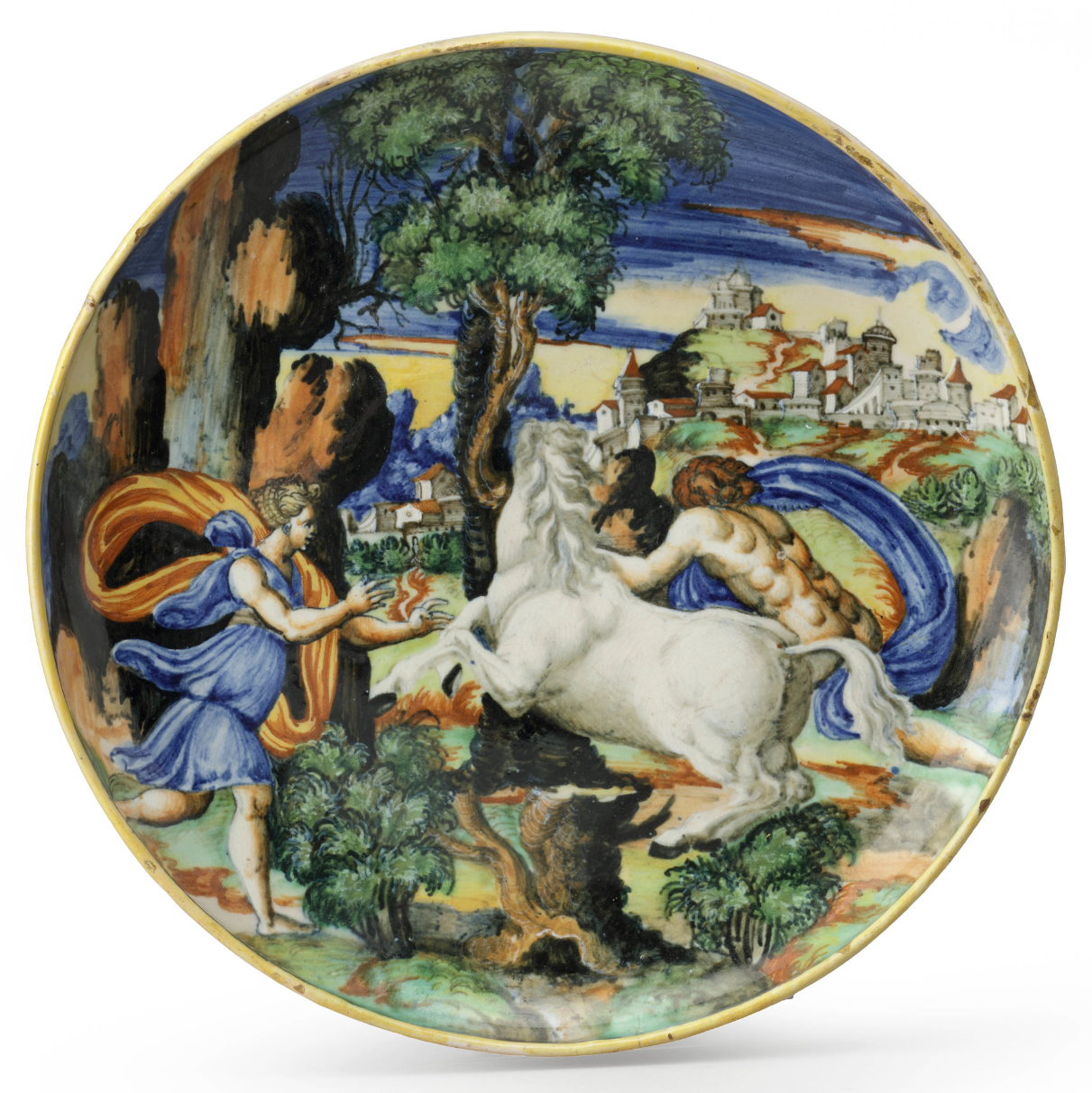
Nicola Pellipario
Greatest Istoriato painter who decorated Castel Durante and Urbino wares; His palette is soft and harmonious, and his subjects, drawn chiefly from Ovid and Lucian, are lyrically rendered
Passeri
An Italian antiquary distinction, claims the discovery of the ware for Pesaro; Affixed the date 1492 to the introduction of Majolica ware
Lucca Della Robia
Italian goldsmith and sculptor who discovered the use of stanniferous enamel, the hardest glaze then in use; Credited to the one to raise production of majolica from a craft to high art
Master Giorgio Andreoli
Known to have perfected the luster technique; Hired to embellish the work of other workshops
Francesco de Medici
Grand duke of Tuscany who produced an inferior type of soft-paste porcelain in the 16th century
Doccia Ware
Porcelain produced at a factory near Florence founded by Marchese Carlo Ginori in 1735; Principal features are imitation of majolica and successful reproduction of the bas reliefs of Della Robia; Three decorative themes distinguish this ware: a galletto, a tulipano pattern, range of polychrome or white-figured reliefs of mythological subjects
A galletto
Design of Chinese origin consisting of two fighting cocks
A tulipano
Design featuring a central, stylized red tulip with surrounding flowers
Capodimonte Porcelain
Founded by Charles III in Naples, Italy. Made in direct emulation of Meissen porcelain characterized by a pronounced creamy color and an unusually glossy clear glaze; Famous for its moulded figurines and its decorative modelled flowers applied to cups and vases
Commedia Dell'arte
A form of improvised theater that originated in Italy in the 16th century and became popular throughout Europe during the Renaissance
Delft Ware
Blue and white Dutch pottery in the 16th Century; Soft-boiled earthenware fired at a relatively low temperature and covered with a tin-based glaze decorated with windmills and fishing boats
De Koninklijke Porceleyne Fles
Only remaining original producer of Dutch delftware; Means Royal Porcelain Jar
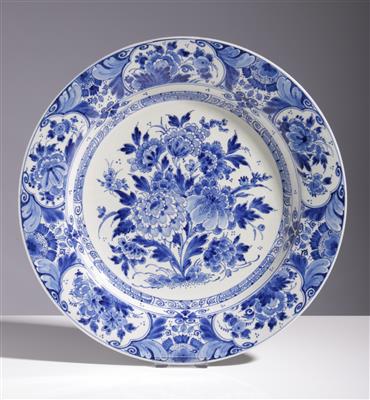
Peasant Delft
A type of delftware that is distinctive in which the decoration is treated; Has a broad style of painting with motifs so simplified; Used to decorate farm stables in the summer season when they were used for social gatherings
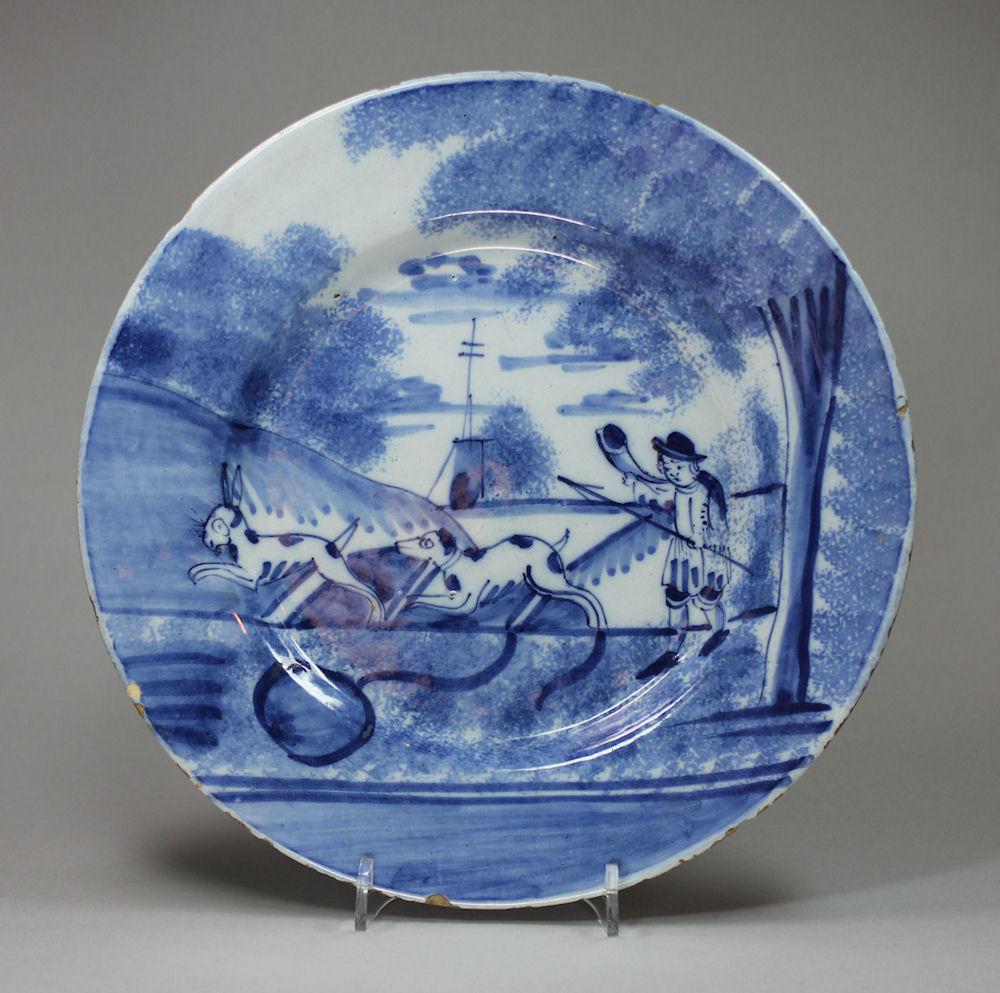
Amstel
Had a fine white body, said to be the best quality, closely resembling the body of Dresden china, and their tableware and utilitarian containers suited the upper class
Hague
Known for its high quality and exquisite craftsmanship, often rivaling the famous porcelain produced in other European centers; Decorated and refired black porcelain pieces produced elsewhere;
French Ceramics
Faience potteries, or tin-enameled earthenware; Had close alliance with religious events and projected by crowned heads or royal houses; Has a love for detail and nice appreciation of completeness, and has a more elegant and artistic pottery work than Germany or Holland.
Terre de Pipe
Its pure whiteness and fineness affording excellent qualities which went far towards perfecting the French styles of decoration
Fayence d’Oiron
Also known as Henri II Ware and Saint-Porchaire Ware; Very first high quality French pottery made for a restricted French clientele; True pipe clay with a transparent thin lead-glaze, and a yellowish-tint
Fontainebleau School
A distinctive style of Mannerist decoration and design that emerged in France during the Renaissance; Characteristics include elaborate ornamentation, mythological and allegorical themes, illusionistic techniques, and integration of architecture and decoration
Bernard Palissy
Succeeded in producing a widely imitated pottery, admired for smooth glazes in richly colored enamels; He was appointed as royal potter to Catherine de Medici reproducing scriptural and mythological subject in low relief and for his rustic pieces decorated with sharply modeled forms copied from nature
Rouen Faience Factory
Factory by the Poterat family; Experiments resulted in some of the earliest examples of soft-paste porcelain made in France; Has bluish and distinctive underglaze blue decoration.
Saint-Cloud Factory
Imitated Chinese blue-and-white porcelain but soon decorated with French prints of 16th and 17th C; The underglaze blue decorative scheme of Chinese porcelain was retained but the subject matter was typically French and the vocabulary of foliage, scrollwork, and animals or human heads
Chantilly factory
Soft-paste factory in France established by Louis Henry, the duc de Bourbon; Copied Japanese pieces while others were executed in a style reminiscent of Japanese porcelain
French Factory of Mennecy
French factory founded by Francois Barbin in the town of Villeroy; Produced utilitarian ware of considerable originality and naïve charm
Vincennes factory
French soft-paste porcelain factory established in 1740; Developed a superior soft-paste porcelain body that was whiter and freer of imperfections than any of its French rivals, as well as hiring the most talented French artists to design shapes and provide drawings and prints for the factory's painters
Sèvres Factory
Flourished because of their constant innovation and new forms were always in development: It was backed by Louis XV; Assumed leadership in Europe and continued to set standards for European porcelain production
Limoges Factory
French hard-paste porcelain factory established in 1774; Made the finest, purest white porcelain in the world; Known for their quality and innovation in the universal expositions organized in various parts of the world
Hafner Ware
A German lead-glazed earthenware, popular in 16th cent. and 17th cent.
Poterie Deluxe
German pottery exceedingly fine in color, form and ornament; Highest eminence which German pottery reached
Johann Friedrich Bottger
Discovered the materials required to produce a white, translucent, high-fired porcelain body, introducing to Europe the art of making true hard-paste porcelain of the Chinese type
Böttger Stoneware
First European hard-paste porcelain produced by Johann Friedrich Böttger who was credited with the discovery of European porcelain
Meissen Factory
The first European manufactory of hard-paste porcelain
Dresden Ware
Porcelain ware, especially delicate and elegantly decorative objects and figures of high quality, made at Meissen; Produced creamy white porcelain called Böttger porcelain; Developed a new and extensive range of enamel colors, and excelled in chinoiserie scenes; Produced large-scale vases decorated with ground colors in imitation of Chinese porcelain
Du Pacquier Factory
Second factory in Europe to produce hard-paste porcelain; Established by Claudius du Paquier at 1719
Hispano-Mosque Wares
Synthesis of Near Eastern and European styles; Heavy earthenware usually decorated with crude patterns in green-blue, yellow, white and lusterware
Lustreware
Also called Hispano Mauresque; A type of pottery or porcelain with a metallic glaze that gives the effect of iridescence, produced by metallic oxides in an overglaze finish, which is given a second firing at a lower temperature in a muffle kiln, reduction kiln, which excludes oxygen.
Albarelli
A type of majolica earthenware jar, originally a medicinal jar designed to hold apothecaries' ointments and dry drugs
Majolica
Spanish tin glazes and enameled earthenware; Glazed floors and wall tiles decorated with flower and abstract motifs showing fusion of Renaissance and Moorish motifs